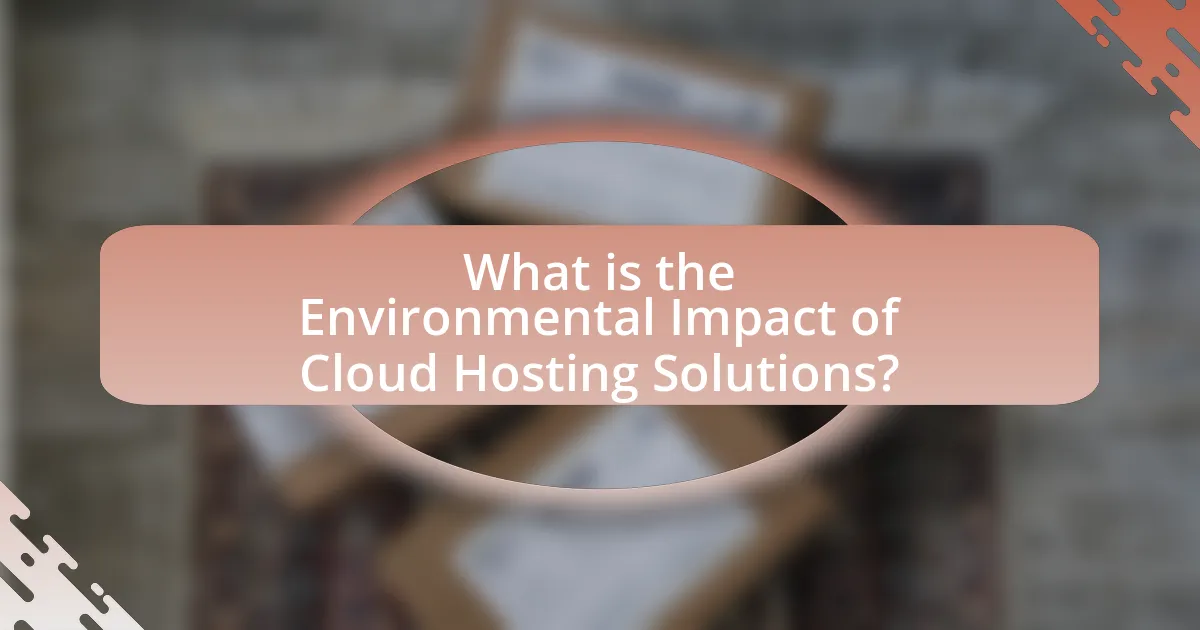The article examines the environmental impact of cloud hosting solutions, highlighting the significant energy consumption and carbon emissions associated with data centers. It discusses how these facilities contribute to greenhouse gas emissions, particularly when powered by fossil fuels, and addresses concerns related to electronic waste and resource depletion. The article also explores the role of renewable energy in mitigating these impacts, the challenges of implementing sustainable practices, and the benefits of cloud hosting in reducing overall resource consumption. Additionally, it outlines strategies for businesses to minimize their environmental footprint while utilizing cloud services.

What is the Environmental Impact of Cloud Hosting Solutions?
Cloud hosting solutions have a significant environmental impact primarily due to their energy consumption and carbon emissions. Data centers, which are the backbone of cloud hosting, require substantial electricity for both operation and cooling, contributing to greenhouse gas emissions. For instance, a report by the International Energy Agency (IEA) indicated that data centers accounted for about 1% of global electricity demand in 2020, and this figure is projected to rise as cloud services expand. Additionally, many cloud providers are increasingly investing in renewable energy sources to mitigate their carbon footprint, with companies like Google and Microsoft committing to operate on 100% renewable energy. However, the overall environmental impact remains a concern, particularly in regions where fossil fuels dominate the energy mix.
How do cloud hosting solutions contribute to environmental changes?
Cloud hosting solutions contribute to environmental changes primarily through their energy consumption and carbon emissions. Data centers, which are the backbone of cloud hosting, require significant amounts of electricity to operate and cool servers. According to the International Energy Agency, data centers accounted for about 1% of global electricity demand in 2020, and this figure is expected to rise as cloud services expand. Furthermore, if the energy used by these data centers is sourced from fossil fuels, it leads to increased greenhouse gas emissions, exacerbating climate change. Additionally, the production and disposal of hardware used in cloud hosting also contribute to environmental degradation through resource extraction and electronic waste.
What are the primary environmental concerns associated with cloud hosting?
The primary environmental concerns associated with cloud hosting include high energy consumption, electronic waste, and carbon emissions. Cloud data centers require significant electricity to operate and cool servers, contributing to increased energy demand. For instance, a report by the International Energy Agency indicated that data centers consumed about 1% of global electricity in 2020, with projections suggesting this could rise. Additionally, the rapid turnover of hardware in cloud environments leads to substantial electronic waste, which poses disposal and recycling challenges. Furthermore, many cloud providers rely on fossil fuels for energy, resulting in considerable carbon emissions, which exacerbate climate change.
How does energy consumption in cloud data centers affect the environment?
Energy consumption in cloud data centers significantly affects the environment by contributing to greenhouse gas emissions and increasing the demand for fossil fuels. Data centers require substantial electricity to operate servers and cooling systems, with estimates indicating that they consume about 1-2% of the global electricity supply. This high energy demand often leads to increased carbon emissions, particularly when the electricity is sourced from non-renewable energy. For instance, a report by the International Energy Agency (IEA) states that data centers emitted approximately 200 million tons of CO2 in 2018, highlighting their role in climate change. Additionally, the environmental impact extends to resource depletion and habitat destruction associated with energy production, further exacerbating ecological issues.
What role do renewable energy sources play in cloud hosting?
Renewable energy sources play a crucial role in cloud hosting by significantly reducing the carbon footprint associated with data centers. Data centers consume a substantial amount of electricity, and transitioning to renewable energy, such as solar, wind, and hydroelectric power, helps mitigate greenhouse gas emissions. For instance, a report by the International Energy Agency indicates that data centers accounted for about 1% of global electricity demand in 2020, and utilizing renewable energy can lower this impact. Companies like Google and Microsoft have committed to operating their data centers on 100% renewable energy, demonstrating a shift towards sustainable practices in the cloud hosting industry. This transition not only supports environmental sustainability but also enhances corporate responsibility and can lead to cost savings in the long term.
How can cloud providers utilize renewable energy to reduce their carbon footprint?
Cloud providers can utilize renewable energy by investing in solar, wind, and hydroelectric power sources to power their data centers. By transitioning to these sustainable energy sources, cloud providers significantly lower their reliance on fossil fuels, which are major contributors to carbon emissions. For instance, Google has committed to operating on 100% renewable energy since 2017, demonstrating that large-scale cloud operations can effectively reduce their carbon footprint. Additionally, according to a report by the International Energy Agency, data centers powered by renewable energy can reduce greenhouse gas emissions by up to 80% compared to those relying on conventional energy sources. This shift not only mitigates environmental impact but also aligns with global sustainability goals.
What are the challenges of implementing renewable energy in cloud hosting?
The challenges of implementing renewable energy in cloud hosting include high initial costs, energy storage issues, and the intermittent nature of renewable sources. High initial costs arise from the investment required for infrastructure upgrades and renewable energy technologies, which can deter cloud service providers from transitioning. Energy storage issues complicate the reliable supply of power, as renewable sources like solar and wind are not always available when demand peaks. Additionally, the intermittent nature of these energy sources can lead to fluctuations in energy supply, making it difficult for cloud hosting services to maintain consistent uptime and performance. These factors collectively hinder the widespread adoption of renewable energy in cloud hosting environments.

What are the benefits of using cloud hosting solutions for the environment?
Cloud hosting solutions benefit the environment by reducing energy consumption and carbon emissions. These solutions utilize shared resources in data centers, which are optimized for energy efficiency, leading to lower overall power usage compared to traditional on-premises hosting. For instance, a study by the Global e-Sustainability Initiative found that cloud computing can reduce energy consumption by up to 87% when compared to traditional IT infrastructure. Additionally, many cloud providers invest in renewable energy sources, further decreasing their carbon footprint. This shift not only conserves resources but also supports global efforts to combat climate change.
How can cloud hosting reduce overall resource consumption?
Cloud hosting can reduce overall resource consumption by optimizing server utilization and enabling efficient resource allocation. Traditional hosting often involves underutilized physical servers, leading to wasted energy and space. In contrast, cloud hosting utilizes virtualization technology, allowing multiple virtual servers to run on a single physical server, which maximizes hardware efficiency. According to a study by the Global e-Sustainability Initiative, cloud computing can reduce energy consumption by up to 87% compared to traditional IT infrastructure. This significant reduction is achieved through shared resources, dynamic scaling, and centralized management, which collectively minimize the carbon footprint associated with energy use and hardware production.
What efficiencies do cloud solutions offer compared to traditional hosting?
Cloud solutions offer significant efficiencies compared to traditional hosting, primarily through scalability, cost-effectiveness, and resource optimization. Scalability allows businesses to adjust their resources dynamically based on demand, reducing waste and ensuring optimal performance. Cost-effectiveness is achieved as cloud solutions typically operate on a pay-as-you-go model, minimizing upfront capital expenditures and ongoing maintenance costs associated with physical servers. Resource optimization occurs because cloud providers utilize advanced technologies and data centers that operate at higher efficiency levels, often resulting in lower energy consumption per unit of computing power. For instance, a study by the Global e-Sustainability Initiative found that cloud computing can reduce energy consumption by up to 87% compared to traditional on-premises IT infrastructure.
How does cloud hosting facilitate better resource allocation?
Cloud hosting facilitates better resource allocation by enabling dynamic scaling of resources based on demand. This means that cloud services can automatically adjust the amount of computing power, storage, and bandwidth allocated to applications in real-time, ensuring that resources are used efficiently. For instance, according to a study by the International Data Corporation, organizations utilizing cloud infrastructure can reduce their IT resource costs by up to 30% due to optimized resource management and reduced waste. This efficiency not only lowers operational costs but also minimizes the environmental impact by reducing energy consumption and carbon emissions associated with underutilized physical servers.
What are the potential negative impacts of cloud hosting on the environment?
Cloud hosting can negatively impact the environment primarily through high energy consumption and electronic waste generation. Data centers, which are essential for cloud hosting, require significant electricity to operate and cool servers, contributing to increased carbon emissions, especially if powered by fossil fuels. For instance, a report by the International Energy Agency indicated that data centers accounted for about 1% of global electricity demand in 2020, with projections suggesting this could rise as cloud services expand. Additionally, the rapid turnover of hardware in data centers leads to substantial electronic waste, with the Global E-waste Monitor estimating that 53.6 million metric tons of e-waste were generated globally in 2019, much of which is not recycled properly, causing further environmental harm.
How does the physical infrastructure of cloud hosting affect land use?
The physical infrastructure of cloud hosting significantly affects land use by necessitating large data centers that require substantial land areas. These data centers often occupy previously undeveloped land or repurposed industrial sites, leading to changes in land use patterns. For instance, a report by the International Data Corporation indicates that the global demand for data centers has led to the construction of facilities that can span over 100 acres, impacting local ecosystems and land availability. Additionally, the energy and cooling requirements of these infrastructures can lead to further land use changes, as they may necessitate the development of additional energy sources, such as solar farms or wind turbines, to meet sustainability goals.
What are the implications of electronic waste from cloud services?
Electronic waste from cloud services poses significant environmental implications, primarily due to the disposal of outdated or malfunctioning data center hardware. As cloud services expand, the demand for servers, storage devices, and networking equipment increases, leading to a rise in electronic waste generation. According to the Global E-waste Monitor 2020, approximately 53.6 million metric tons of electronic waste were generated globally, with data centers contributing a notable portion of this total. Improper disposal of this waste can result in hazardous materials, such as lead and mercury, leaching into the environment, contaminating soil and water sources. Furthermore, the energy-intensive nature of cloud services exacerbates the issue, as the production and disposal of electronic components contribute to carbon emissions, impacting climate change.

How can businesses mitigate the environmental impact of cloud hosting?
Businesses can mitigate the environmental impact of cloud hosting by adopting energy-efficient data centers and utilizing renewable energy sources. Energy-efficient data centers reduce power consumption through advanced cooling technologies and optimized hardware, which can lead to a reduction in carbon emissions. For instance, according to the International Energy Agency, data centers accounted for about 1% of global electricity demand in 2020, highlighting the importance of efficiency improvements. Additionally, transitioning to renewable energy sources, such as solar or wind power, can significantly lower the carbon footprint associated with cloud services. Companies like Google and Microsoft have committed to operating their data centers on 100% renewable energy, demonstrating the feasibility and effectiveness of this approach.
What strategies can organizations implement to reduce their cloud footprint?
Organizations can implement several strategies to reduce their cloud footprint, including optimizing resource usage, adopting serverless architectures, and utilizing multi-cloud environments. Optimizing resource usage involves rightsizing instances and employing auto-scaling to ensure that only necessary resources are utilized, which can lead to significant energy savings. Adopting serverless architectures allows organizations to run applications without provisioning servers, thereby reducing idle resources and energy consumption. Utilizing multi-cloud environments enables organizations to distribute workloads across different cloud providers, allowing them to select the most energy-efficient options available. According to a report by the International Energy Agency, optimizing cloud infrastructure can lead to a reduction in energy consumption by up to 30%.
How can companies choose eco-friendly cloud providers?
Companies can choose eco-friendly cloud providers by evaluating their sustainability practices, energy sources, and carbon footprint reduction initiatives. Specifically, companies should look for providers that utilize renewable energy sources, such as solar or wind, to power their data centers, as this significantly reduces greenhouse gas emissions. Additionally, companies can assess the provider’s commitment to energy efficiency through certifications like ISO 50001 or the Energy Star program, which indicate adherence to best practices in energy management. Furthermore, reviewing the provider’s transparency in reporting carbon emissions and sustainability goals can provide insights into their environmental impact. For instance, a 2021 report by the International Energy Agency highlighted that data centers powered by renewable energy can reduce emissions by up to 80%. By focusing on these criteria, companies can make informed decisions that align with their sustainability objectives.
What practices can businesses adopt to optimize their cloud usage?
Businesses can optimize their cloud usage by implementing resource management strategies, such as rightsizing instances, utilizing auto-scaling, and adopting serverless architectures. Rightsizing involves selecting the appropriate instance types and sizes based on actual usage, which can reduce costs and energy consumption. Auto-scaling automatically adjusts resources based on demand, ensuring that businesses only use what they need, thereby minimizing waste. Serverless architectures allow businesses to run applications without managing servers, which can lead to more efficient resource utilization. According to a report by the International Energy Agency, optimizing cloud usage can lead to significant reductions in energy consumption, contributing to lower carbon emissions associated with cloud services.
What are the best practices for sustainable cloud hosting?
The best practices for sustainable cloud hosting include optimizing energy efficiency, utilizing renewable energy sources, implementing efficient resource management, and promoting carbon offset initiatives. Optimizing energy efficiency involves using advanced cooling technologies and energy-efficient hardware to reduce power consumption. Utilizing renewable energy sources, such as solar or wind power, significantly lowers the carbon footprint of data centers. Efficient resource management, including virtualization and containerization, maximizes resource utilization and minimizes waste. Additionally, promoting carbon offset initiatives helps mitigate the environmental impact by investing in projects that reduce greenhouse gas emissions. These practices collectively contribute to a more sustainable cloud hosting environment.
How can monitoring and reporting improve environmental outcomes in cloud hosting?
Monitoring and reporting can significantly improve environmental outcomes in cloud hosting by enabling organizations to track energy consumption, carbon emissions, and resource utilization in real-time. This data allows for informed decision-making, leading to optimized resource allocation and reduced waste. For instance, a study by the Global e-Sustainability Initiative found that effective monitoring can lead to a 20-30% reduction in energy use in data centers. By identifying inefficiencies and implementing corrective measures based on accurate reporting, cloud hosting providers can enhance their sustainability efforts and contribute to lower overall environmental impacts.
What role does user awareness play in minimizing environmental impact?
User awareness plays a crucial role in minimizing environmental impact by influencing consumer behavior towards sustainable practices. When users are informed about the environmental consequences of their digital activities, such as energy consumption and carbon emissions associated with cloud hosting, they are more likely to make conscious choices that reduce their ecological footprint. For instance, studies indicate that informed users tend to opt for energy-efficient services and support providers that prioritize sustainability, thereby driving demand for greener technologies. This shift in user behavior can lead to significant reductions in overall energy usage and emissions, as evidenced by research from the International Energy Agency, which highlights that increased awareness can lead to a 10-20% reduction in energy consumption in data centers.
What future trends are shaping the environmental impact of cloud hosting?
Future trends shaping the environmental impact of cloud hosting include increased energy efficiency, the adoption of renewable energy sources, and advancements in cooling technologies. Energy efficiency is being prioritized as cloud providers aim to reduce their carbon footprints; for instance, major companies like Google and Microsoft have committed to operating data centers with 100% renewable energy by 2025. The shift towards renewable energy is evidenced by the fact that in 2021, the global share of renewable energy in electricity generation reached 29%, indicating a growing trend among cloud providers to source their energy sustainably. Additionally, innovations in cooling technologies, such as liquid cooling and AI-driven thermal management, are being implemented to minimize energy consumption in data centers, further reducing their environmental impact.
How is technology evolving to create greener cloud solutions?
Technology is evolving to create greener cloud solutions through advancements in energy efficiency, renewable energy integration, and innovative cooling techniques. Data centers are increasingly utilizing artificial intelligence to optimize energy consumption, reducing waste and improving operational efficiency. For instance, Google reported a 50% reduction in energy usage for cooling through AI-driven management systems. Additionally, many cloud providers are committing to 100% renewable energy usage; for example, Microsoft aims to be carbon negative by 2030, which includes investing in renewable energy projects. Furthermore, the adoption of edge computing minimizes latency and energy consumption by processing data closer to the source, thereby reducing the need for extensive data transmission. These technological advancements collectively contribute to a more sustainable cloud infrastructure.
What innovations are on the horizon for sustainable cloud hosting?
Innovations on the horizon for sustainable cloud hosting include advancements in energy-efficient data centers, the integration of renewable energy sources, and the development of carbon-neutral cloud services. Energy-efficient data centers utilize advanced cooling technologies and AI-driven resource management to reduce energy consumption significantly. For instance, companies like Google have reported up to 50% energy savings through machine learning algorithms that optimize power usage. The integration of renewable energy sources, such as solar and wind, is becoming standard practice, with major providers committing to 100% renewable energy usage by 2025. Additionally, the emergence of carbon-neutral cloud services, where providers offset their carbon emissions through various initiatives, is gaining traction, as seen in Microsoft’s commitment to being carbon negative by 2030. These innovations collectively aim to minimize the environmental impact of cloud hosting solutions.
What practical steps can organizations take to enhance sustainability in cloud hosting?
Organizations can enhance sustainability in cloud hosting by adopting energy-efficient data centers, utilizing renewable energy sources, and optimizing resource allocation. Energy-efficient data centers reduce power consumption through advanced cooling technologies and efficient hardware, which can lower energy usage by up to 30% according to the U.S. Department of Energy. Utilizing renewable energy sources, such as solar or wind, can significantly decrease carbon footprints; for instance, major cloud providers like Google and Microsoft have committed to operating on 100% renewable energy. Additionally, optimizing resource allocation through virtualization and containerization can lead to better utilization of hardware, reducing waste and energy consumption. These steps collectively contribute to a more sustainable cloud hosting environment.


